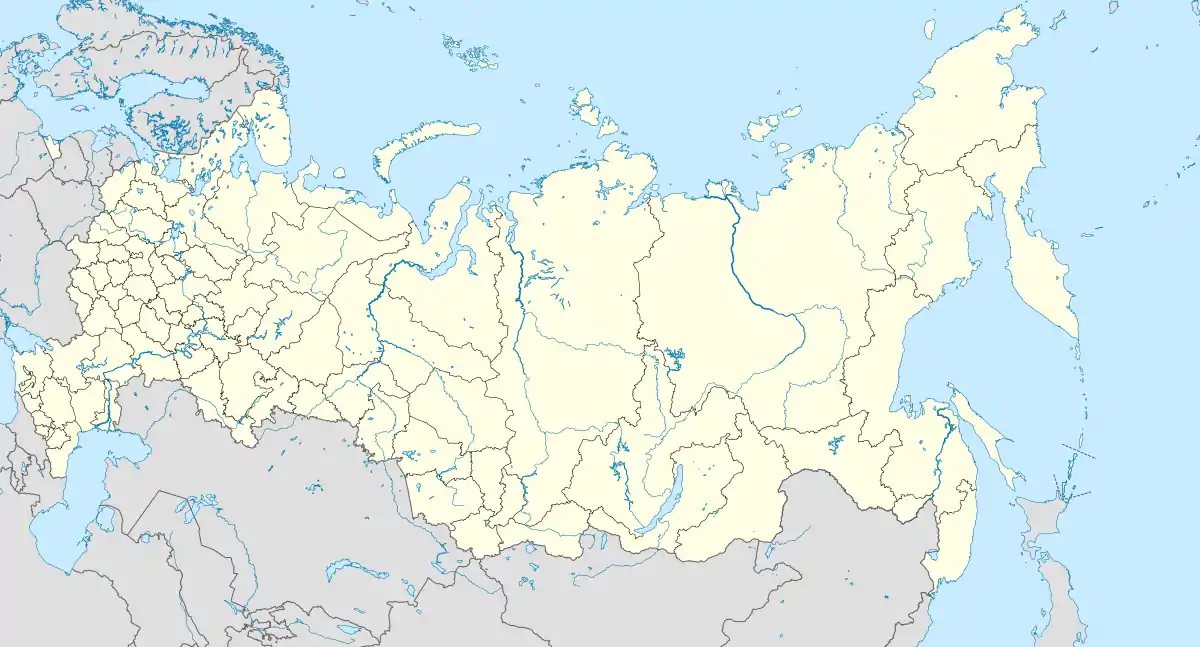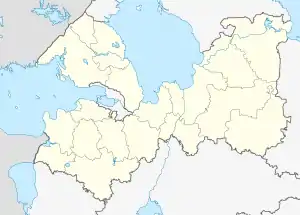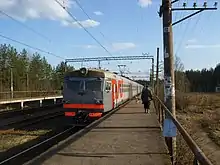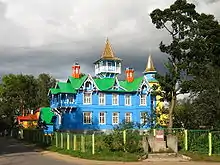Vyritsa
Vyritsa (Russian: Вы́рица, Finnish: Viiritsa) is an urban locality (an urban-type settlement) in Gatchinsky District of Leningrad Oblast, Russia, located on the bank of the Oredezh River, southwest of the town of Gatchina. Population: 11,884 (2010 Census);[4] 11,163 (2002 Census);[9] 12,656 (1989 Census).[10]
Vyritsa
Вырица | |
|---|---|
Urban-type settlement[1] | |
Location of Vyritsa 
| |
 Vyritsa Location of Vyritsa  Vyritsa Vyritsa (Leningrad Oblast) | |
| Coordinates: 59°24′40″N 30°20′50″E | |
| Country | Russia |
| Federal subject | Leningrad Oblast |
| Administrative district | Gatchinsky District[1] |
| Station and suburban settlement | 1903[2] |
| Urban-type settlement status since | 1938[3] |
| Population | |
| • Total | 11,884 |
| • Estimate (2018)[5] | 12,341 (+3.8%) |
| • Municipal district | Gatchinsky Municipal District[6] |
| • Urban settlement | Vyritskoye Urban Settlement[6] |
| • Capital of | Vyritskoye Urban Settlement[6] |
| Time zone | UTC+3 (MSK |
| Postal code(s)[8] | 188380–188382 |
| OKTMO ID | 41618154051 |
| Website | www |
History
Vyritsa railway station was opened in December 1903. The lands around the station became expensive and were quickly sold for summer houses. Originally, Vyritsa was a suburban settlement and belonged to Tsarskoselsky District of Saint Petersburg Governorate (renamed in 1913 Petrograd Governorate and in 1924 Leningrad Governorate). In the 1910s, the population of Vyritsa was increasing every summer by 10,000 people.[2] On November 20, 1918 the uyezd was renamed Detskoselsky. On February 14, 1923 Detskoselsky and Petergofsky Uyezds were abolished and merged into Gatchinsky Uyezd, with the administrative center located in Gatchina.[11] On February 14, 1923 Gatchina was renamed Trotsk, and Gatchinsky Uyezd was renamed Trotsky Uyezd, after Leon Trotsky.[12]
On August 1, 1927, the uyezds were abolished and Trotsky District, with the administrative center in the town of Trotsk, was established. The governorates were also abolished, and the district was a part of Leningrad Okrug of Leningrad Oblast. On August 2, 1929, after Trotsky was deported from Soviet Union, Trotsk was renamed Krasnogvardeysk, and the district was renamed Krasnogvardeysky. On July 23, 1930, the okrugs were abolished as well, and the districts were directly subordinated to the oblast. On November 27, 1938 Vyritsa was granted urban-type settlement status.[3] Between 1941 and 1944, Vyritsa was occupied by Romanian[2] troops. On January 28, 1944 Krasnogvardeysk was renamed Gatchina, and the district was renamed Gatchinsky.[3]
Economy
Industry
In Vyritsa, there are enterprises of timber, textile, and food industries.[13]
Transportation

Vyritsa is located on the railroad connecting the Vitebsky railway station of Saint Petersburg with Novosokolniki via Dno. There are two stations on the main line, Vyritsa railway station and Mikhaylovka railway station. Additionally, a railroad branches off at Vyritsa railway station and proceeds southwest along the main axis of the settlement. There are four more railway stations at this branch, all directly served from the Vitebsky railway station: Pervaya Platforma, Vtoraya Platforma, Tretya Platforma, and Posyolok.
Vyritsa is connected by roads with Gatchina, Pavlovsk, Volosovo, and Tosno.
Culture and recreation

Vyritsa contains four objects classified as cultural and historical heritage of local significance.[14] These are an archeological site, two monuments commemorating the events of World War II, and the birthplace of author and paleonthologist Ivan Yefremov.
Serafim Vyritsky, who was previously a monk with Alexander Nevsky Lavra in Saint Peterburg, lived in Vyritsa from 1930 to 1949. He died and is buried in Vyritsa. He was later canonized as a saint by the Russian Orthodox Church.[15]
References
Notes
- Государственный комитет Российской Федерации по статистике. Комитет Российской Федерации по стандартизации, метрологии и сертификации. №ОК 019-95 1 января 1997 г. «Общероссийский классификатор объектов административно-территориального деления. Код 41 218 554 004», в ред. изменения №278/2015 от 1 января 2016 г.. (State Statistics Committee of the Russian Federation. Committee of the Russian Federation on Standardization, Metrology, and Certification. #OK 019-95 January 1, 1997 Russian Classification of Objects of Administrative Division (OKATO). Code 41 218 554 004, as amended by the Amendment #278/2015 of January 1, 2016. ).
- Барановский, Александр Симо, Андрей; Симо, Александр. История (in Russian). Посёлокъ Вырица. Retrieved 15 February 2013.
- Троцкий район (август 1927 г . - август 1929 г .), Красногвардейский район (август 1929 г. - январь1944), Гатчинский район (январь 1944 г. ) (in Russian). Система классификаторов исполнительных органов государственной власти Санкт-Петербурга. Retrieved February 8, 2013.
- Russian Federal State Statistics Service (2011). "Всероссийская перепись населения 2010 года. Том 1" [2010 All-Russian Population Census, vol. 1]. Всероссийская перепись населения 2010 года [2010 All-Russia Population Census] (in Russian). Federal State Statistics Service.
- "26. Численность постоянного населения Российской Федерации по муниципальным образованиям на 1 января 2018 года". Federal State Statistics Service. Retrieved 23 January 2019.
- Law #116-oz
- "Об исчислении времени". Официальный интернет-портал правовой информации (in Russian). 3 June 2011. Retrieved 19 January 2019.
- Почта России. Информационно-вычислительный центр ОАСУ РПО. (Russian Post). Поиск объектов почтовой связи (Postal Objects Search) (in Russian)
- Russian Federal State Statistics Service (21 May 2004). "Численность населения России, субъектов Российской Федерации в составе федеральных округов, районов, городских поселений, сельских населённых пунктов – районных центров и сельских населённых пунктов с населением 3 тысячи и более человек" [Population of Russia, Its Federal Districts, Federal Subjects, Districts, Urban Localities, Rural Localities—Administrative Centers, and Rural Localities with Population of Over 3,000] (XLS). Всероссийская перепись населения 2002 года [All-Russia Population Census of 2002] (in Russian).
- "Всесоюзная перепись населения 1989 г. Численность наличного населения союзных и автономных республик, автономных областей и округов, краёв, областей, районов, городских поселений и сёл-райцентров" [All Union Population Census of 1989: Present Population of Union and Autonomous Republics, Autonomous Oblasts and Okrugs, Krais, Oblasts, Districts, Urban Settlements, and Villages Serving as District Administrative Centers]. Всесоюзная перепись населения 1989 года [All-Union Population Census of 1989] (in Russian). Институт демографии Национального исследовательского университета: Высшая школа экономики [Institute of Demography at the National Research University: Higher School of Economics]. 1989 – via Demoscope Weekly.
- Царскосельский уезд (1917 - нояб. 1918), Детскосельский уезд (ноябрь1918 - фев.1923) (in Russian). Система классификаторов исполнительных органов государственной власти Санкт-Петербурга. Retrieved January 24, 2013.
- Гатчинский уезд (февр. 1923-авг. 1927) (in Russian). Система классификаторов исполнительных органов государственной власти Санкт-Петербурга. Retrieved February 8, 2013.
- Справочник предприятий Ленинградской области (in Russian). Справочник предприятий Ленинградская область. Желтые страницы 2013. Retrieved 15 February 2013.
- Памятники истории и культуры народов Российской Федерации (in Russian). Russian Ministry of Culture. Retrieved 2 June 2016.
- Васильев, Иван. Вырицкий старец (in Russian). Ассоциация предприятий похоронной области Петербурга и Ленинградской Области. Retrieved 15 February 2013.
Sources
- Законодательное собрание Ленинградской области. Областной закон №32-оз от 15 июня 2010 г. «Об административно-территориальном устройстве Ленинградской области и порядке его изменения», в ред. Областного закона №23-оз от 8 мая 2014 г. «Об объединении муниципальных образований "Приморское городское поселение" Выборгского района Ленинградской области и "Глебычевское сельское поселение" Выборгского района Ленинградской области и о внесении изменений в отдельные Областные законы». Вступил в силу со дня официального опубликования. Опубликован: "Вести", №112, 23 июня 2010 г. (Legislative Assembly of Leningrad Oblast. Oblast Law #32-oz of June 15, 2010 On the Administrative-Territorial Structure of Leningrad Oblast and on the Procedures for Its Change, as amended by the Oblast Law #23-oz of May 8, 2014 On Merging the Municipal Formations of "Primorskoye Urban Settlement" in Vyborgsky District of Leningrad Oblast and "Glebychevskoye Rural Settlement" in Vyborgsky District of Leningrad Oblast and on Amending Various Oblast Laws. Effective as of the day of the official publication.).
- Законодательное собрание Ленинградской области. Областной закон №113-оз от 16 декабря 2004 г. «Об установлении границ и наделении соответствующим статусом муниципального образования Гатчинский муниципальный район и муниципальных образований в его составе», в ред. Областного закона №17-оз от 6 мая 2010 г «О внесении изменений в некоторые областные законы в связи с принятием федерального закона "О внесении изменений в отдельные законодательные акты Российской Федерации в связи с совершенствованием организации местного самоуправления"». Вступил в силу через 10 дней со дня официального опубликования (27 декабря 2004 г.). Опубликован: "Вести", №147, 17 декабря 2004 г. (Legislative Assembly of Leningrad Oblast. Oblast Law #113-oz of December 16, 2004 On Establishing the Borders of and Granting an Appropriate Status to the Municipal Formation of Gatchinsky Municipal District and to the Municipal Formations It Comprises, as amended by the Oblast Law #17-oz of May 6, 2010 On Amending Various Oblast Laws Due to the Adoption of the Federal Law "On Amending Various Legislative Acts of the Russian Federation Due to the Improvement of the Organization of the Local Self-Government". Effective as of after 10 days from the day of the official publication (December 27, 2004).).